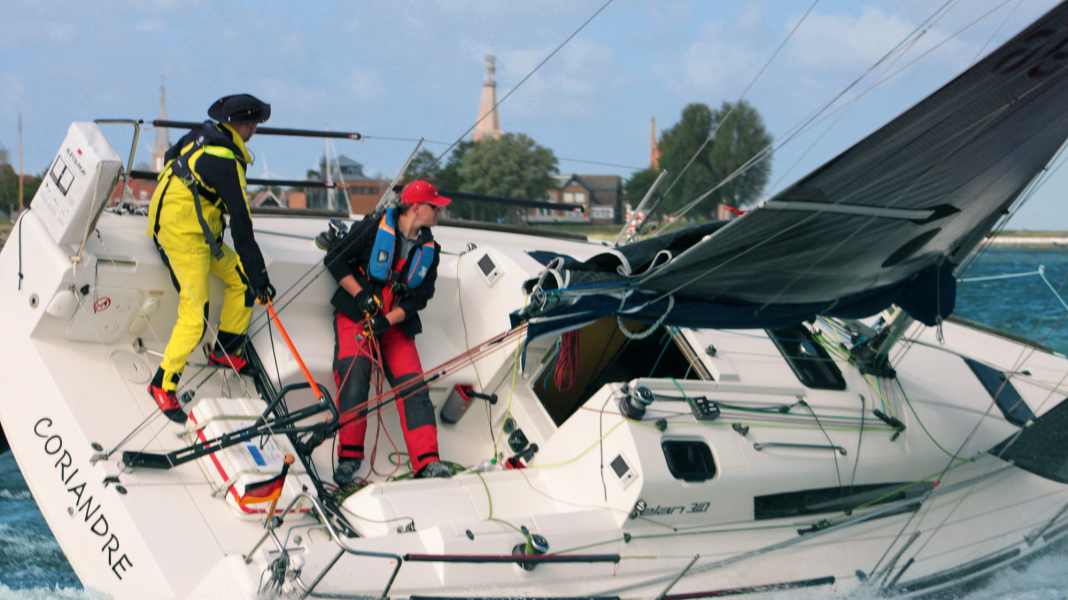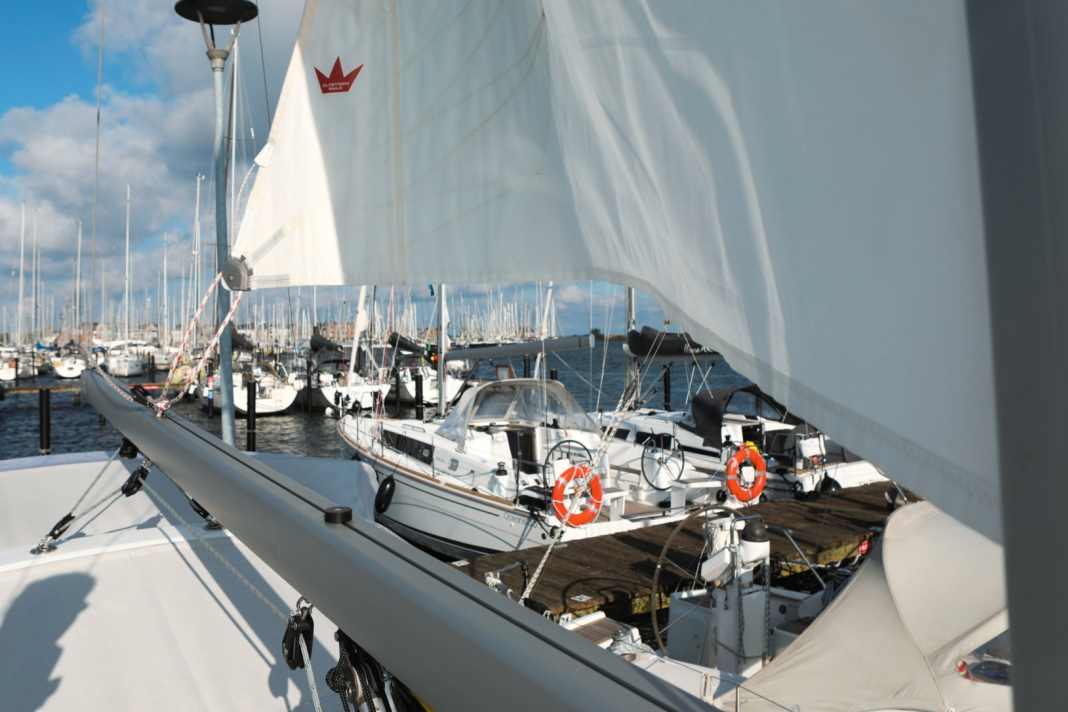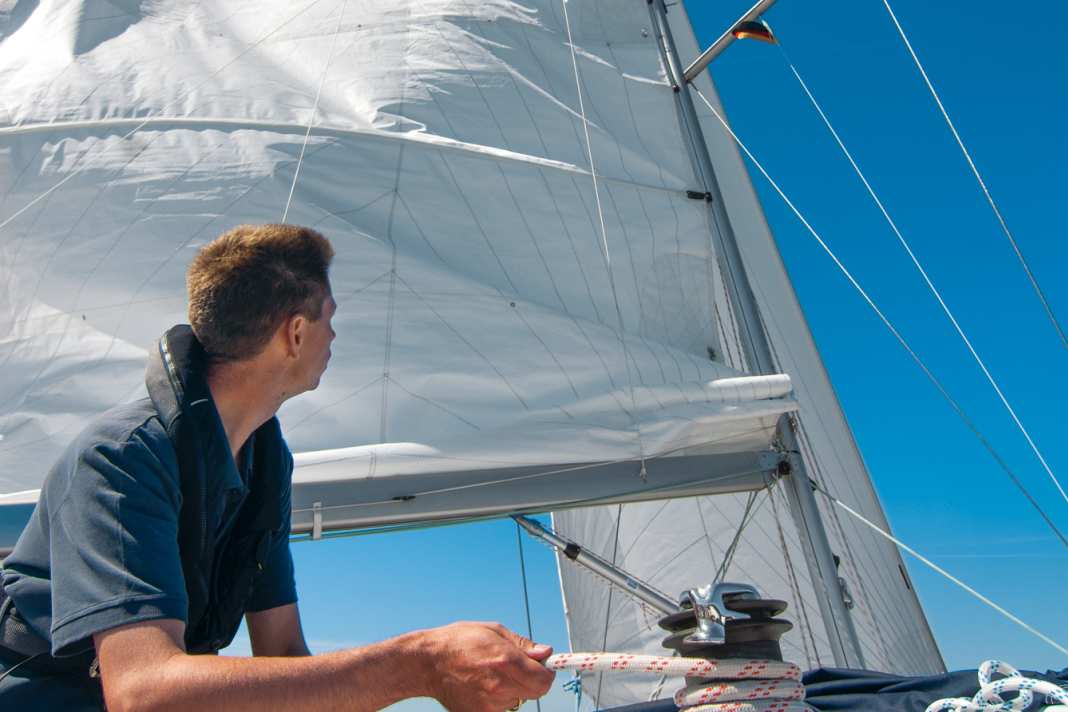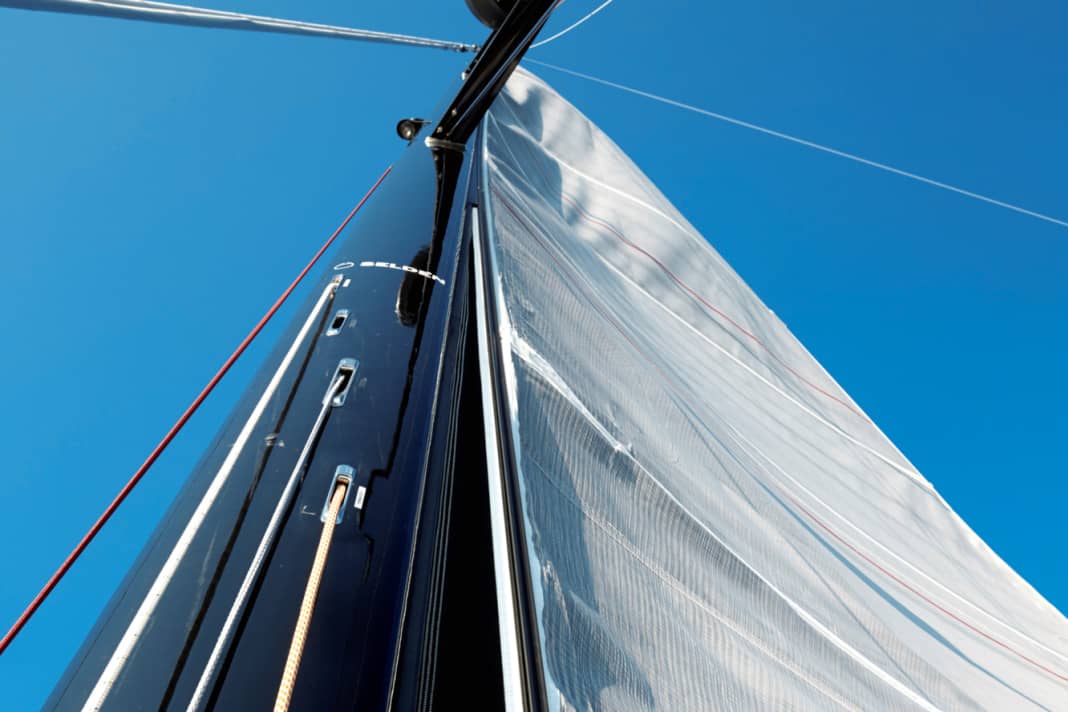
With nervous glances, the charter crew manoeuvres into the harbour with the mainsail flapping loudly. The clew is wrapped around the mast several times in a makeshift fashion, but further up, a large bag forms that keeps catching the wind. The mast pulls the ship wildly back and forth, it bucks unpredictably. Not ideal starting conditions for a successful mooring manoeuvre.
A problem that occurs again and again. The cause: a jammed mainsail. This usually happens when the wind is a little stronger, because the beating during the furling of the cloth, which is travelled with the bow in the wind, causes creases to form when it is furled. At some point, these creases thicken in the mast profile to such an extent that nothing works any more. It jams. The mainsail neither goes in where it is supposed to go nor out. Because then you could at least lower it by halyard.
More on the topic:
Many yachts today with mainsail for furling
There are many possible reasons for unwanted jamming in the mast: incorrect operation with too little counter-pressure on the furling line, furling in the wrong direction, too little tension on the halyard or too much tension on the backstay. With a lot of fiddling, usually with someone in the mast trying to clear the creases as best they can, the cloth usually comes free again. However, this is definitely not a job that can be done at sea.
Nevertheless, many yachts today are equipped with furling mainsails. And for good reason, as they offer comfort and safe, easy handling when operated correctly. But what exactly is correct operation, and what advantages and disadvantages does the system offer compared to a fully battened mainsail with a single-line reef and lazy bag? And what convenient alternatives are there?
A furling mainsail is actually the same as a furling headsail, just in the mast. A profile with a groove into which the sail is pulled, a drive that turns the profile, which can be manual, electric or hydraulic, and a line that pulls the sail out of the mast along the boom. The big difference to the headsail, however, is the confined space in which the cloth has to fit. It must therefore be rolled up neatly. If this doesn't happen with the headsail, it's no problem. Unfurl it once and furl it again, with a little more counter-pressure from the sheet, and the cloth will lie perfectly around the forestay. With the mainsail, however, the scenario described at the beginning can occur if it is wound incorrectly: Everything jams, nothing works. But that doesn't have to be the case.
As the sail is wrapped around the profile in the mast, horizontal battens are not possible as with conventional mainsails. To avoid constantly travelling with a fluttering leech, the leech is cut hollow, concave. This means that the furling mainsail loses surface area compared to other cloths. The problem can be solved by using very long, vertical battens. These are positioned vertically parallel to the mast in the sail and are simply rolled up with it. This allows for more surface area and even a flared leech. A furling mainsail then has hardly any less power than its conventional counterpart.
However, as the battens also have to fit into the already narrow mast profile, special care is required when winding them up. Often, however, the battens simply do not fit in, which is particularly the case if the pole profile is rather small. So if you want to switch from a battenless furling main to a larger surface with battens, you need to discuss this with the sailmaker.
The furling rig is somewhat heavier due to the more complicated mast profile, the sail, which always stays up even when it is reefed, and the profile including the winding device. This increases the top weight, which in turn reduces the righting moment. It is therefore possible that a vessel fulfils the criteria of CE category A with a normal mast, but no longer with a furling rig. In a rough anchorage, the sail may flap back and forth in the mast. This is loud and difficult to stop.
Too much voltage blocks the system
These disadvantages are offset by a whole series of advantages. Once rolled away, the sail is completely taken care of. No halyard to tie off, no snagging zips, no bulky sail cloth. Correctly operated, the cloth can be perfectly adjusted to any wind conditions as it does not have to be reefed in stages. If necessary, the sail can also be furled on deeper courses. This is rather difficult to do, as the cloth suffers due to the strong shamming at the leading edge of the mast. However, if there are no alternatives, it is at least possible. In conjunction with an electric or hydraulic drive, a little dexterity is required. Often one motor turns the profile in the mast and the other moves the outhaul. If the outhaul runs slower than the winding in the mast, too much tension builds up, which can block the system. A clear view of the sail during operation is therefore essential. Of course, this also applies to manual operation.
If two people carry out the sailing manoeuvre, it is also important that they are well coordinated. The winding speed and the tension of the outhaul line must match. With a little practice, it is then also possible to set or hoist the sail when the boat is not in the wind.
Setting, reefing or recovering downwind is very difficult or even impossible with horizontally battened sails. The friction on the rig is too great and the cloth tends to get caught in the lazy-jacks. This can only be remedied with a lot of fiddling and acrobatics.
In order to retrieve the sheet and raise it properly, a smaller angle to the wind must be used; with the mainsheet released, the pressure disappears from the sail. With an appropriately prepared halyard - the sail must be able to run out freely - the cloth falls into the lazy bag or lazy jacks all by itself.
A recovery line on the luff that is redirected into the cockpit can also help and save you having to go on deck to secure the sail when it is recovered so that it does not immediately rise again in every wave. Ideally, reefing works with just one line. Release the halyard, pull the reefing line through, pull the halyard through. That's it. An experienced crew can do this in no time at all. It is less convenient if you have to attach the reefing eye to the mast. Otherwise, the whole system is very simple: a halyard and a few mast slides, there are no more moving parts. If you pay attention to a clean keep in the mast and lubricate sliders or carriages with Teflon spray, it makes things even easier. An electric winch on the coachroof or coaming and a block with a 1:2 ratio on the halyard make the job even easier.
Rolling system in the tree as a solution?
The mainsail itself can be cut by the sailmaker with almost no restrictions: A particularly high profile? A strongly flared top? Very heavy cloth? Loose foot or foot attached to the boom? Many things are possible. These advantages come at the cost of a little more work for the owner: in the harbour it has to be packed properly and then protected from UV radiation. To do this, a zip that is usually long and difficult to reach has to be closed. However, on larger yachts or catamarans in particular, the lazy bag sits so high up that some climbing is required to reach it from the deck. This is particularly problematic in the sprayhood and cockpit area. This is certainly not everyone's cup of tea. As a result, the zip remains open too often and the mainsail ages quickly in the sun.
A furling system in the boom seems to combine the best of both worlds. As the name suggests, the sail is not wrapped in the mast but in the boom. An almost normal sail with horizontal battens is no problem. However, the battens must be wound exactly parallel to the boom. It is therefore extremely important that the mast keel and boom are exactly at right angles to each other when wrapping. Because the mast often has to be bent, a levelling piece must be attached to the mast to level out the deflection.
In addition, with some systems the luff is unthreaded from the mast groove when the sail is recovered to protect it completely from UV radiation. It then disappears completely into the boom. Conversely, the luff must then be threaded into the groove when setting the sail. Some owners leave the head of the sail in the groove and accept the UV exposure, but a watchful eye to ensure that the luff slides smoothly into the groove is still essential when setting the sail. Interaction between the halyard hand and a person on the mast may be necessary. Finally, the boom must also be covered on top to prevent both rain and UV radiation from entering the sail through the opening. The seemingly perfect solution of the two aforementioned boom systems therefore also has some disadvantages. However, many owners swear by it.
Other system: Dutchman Reef
Another option is the so-called Dutchman Reef. Depending on the size of the sail, two to five strong fishing lines are threaded through small thimbles in the sail vertically from the dirk to the boom. When the halyard is released, the mainsail lies on the boom in large folds as if by magic and stays there. After all, it is threaded onto the fishing lines. Single-handed sailors in particular swear by this system. When recovering, the dirk must be set, but this is necessary anyway, at least if there is no rod kicker on board.
The disadvantage of the system, however, is that the sail dress is somewhat fiddly to fit: each chord needs its own side zip. The first port of call for such a system is therefore your own sailmaker. Ideally, they will also supply the dirk with the fishing lines in it. The Dutchman Reef can be retrofitted without any problems. What many owners also appreciate about the system is that it is invisible. No slobbering lazy bag, no additional lines in the mast, just a sheer mainsail.
Regardless of which system is installed on your yacht, it is important to familiarise yourself with it. How can handling be optimised, how can errors and associated problems be avoided? When buying a new yacht, the choice of mainsail recovery system is ultimately a question of personal taste. But perhaps the question doesn't even arise because one of the systems is already installed on your own used dream yacht. While a furling boom can certainly be retrofitted, this only applies to a limited extent to a furling main in the mast. Retrofit kits, such as the CF system from Facnor, are no longer available. It is also not possible to convert a furler to a fully battened cloth, as the mast profile simply does not fit. This usually means replacing the entire rig, which is an immense expense.
Before it gets that far, it makes a lot more sense to familiarise yourself with your own reefing system, as it may be possible to compensate for many disadvantages through practice or sensible investment.
Widespread: Roll large in the mast





Some swear by it, others don't want to know anything about it. Why?
Pros & cons
The furling mast is more complex, but offers a very high level of operating comfort
- + Reefing and recovery possible downwind
- + sail area infinitely adjustable
- + No further work after rolling away
- - Furled sail can rattle in the mast
- - Higher top weight
- - Certain sail shapes complex
- - Sails cannot be recovered in the event of a problem
Tips for the rolling mast
- Important for good rolling is the correct Drop voltage. It must not be too low, as the fabric will then be too bulbous. If the drop tension is too high, the profile will be compressed, making it difficult to move. It is therefore advisable to experiment a little with the tension.
- Backstay tensionIf the mast is bent too much, this also makes it more difficult to turn the profile. In addition, the sail wrinkles at the loose leech. Then there is a risk of jamming. So before hoisting the sail: loosen the backstay!
- If the groove in the mast is not centred, it is advisable not to stand exactly in the wind. Ideally, the person at the rudder should steer so precisely that the sail is in line with the sides of the Groove not touched.
- Too much Train on the outhaul makes unwrapping and wrapping more difficult. Too little leads to creases and jamming during recovery
The classic: Mainsail with Bindereff





Although the system is actually simple to use, it still has its pitfalls. What are they?
Pros & cons
The technical side is simple, but reefing and folding are much more complex
- + Sail shape not restricted
- + Low weight
- + Simple, reliable technology
- + Sail can always be recovered
- - Reefing levels are specified
- - Recovery from the wind difficult
- - Greater handling effort
Tips for the Bindereff
- To make reefing easier Markings on the casewhich indicate how far it must be reefed for the 1st or 2nd reef. This saves having to re-set the halyard when the reefing line is tight
- The Pulleys for the lazy bag lines should high up and attached to the spreaders be. The sail does not get caught in the lines so easily and is therefore easier to set and retrieve
- When there is little wind, it can be very helpful if a crew member on the mast the halyard. This happens very quickly because there is much less friction in the way of a fast manoeuvre
- A quick way to avoid a rattling case is to use a small carabiner on one of the aft eyes of the lazy baginto which the (sufficiently long) halyard is pecked as soon as the cloth is on the tree
The best of both worlds: The rolling tree





It seems logical: wrap the sail and horizontal battens in the boom. But is that it?
Pros & cons
Winding, but horizontally. Is this the ideal solution for reefing and recovery?
- + Full flexibility in the sail shape
- + Can be retrofitted
- + Sheer optics
- + Infinitely variable reefing
- - New mainsail required
- - Precise setting and recovery required
- - Comparatively expensive
Tips for the rolling boom
- As the angle between the boom and mast must be exactly right for the sail to wind correctly on the boom, a Marking on the line of the Rodkickerso that the angle can be set correctly
- With a hydraulic kicker, such a Marking only on the cylinder itself possible
- In order to observe the winding when the sail is recovered, a Camera on the mast which transmits the image to the on-board network. This allows the winding process to be followed in the cockpit on the multifunction display, for example
- Threading the luff when setting the sail can be fiddly. A UV protection at the head of the sail protects this part, similar to the clew on sails that wrap into the mast. This means it can also remain permanently threaded when recovered

